Catalogue > List by artist
Browse the entire list of Rencontre Internationales artists since 2004. Use the alphabetical filter to refine your search. update in progress
Federico Solmi
Catalogue : 2021American Fables | Video | mp4 | | 7:40 | Italy, USA | 2020
Federico Solmi
American Fables
Video | mp4 | | 7:40 | Italy, USA | 2020
Inspired by the legacies of real historical events and manufactured myths, American Fables, re-imagines through video vignettes some of the most celebrated moments in American History. I have long been influenced by the comically one-dimensional and inaccurate accounts of history common to most US textbooks, where ethnocentric perspectives create propagandistic narratives of American exceptionalism. Continuously, I find myself fascinated by the subjectivity of history, its vulnerability to partisan ideals and nationalism, rendering historical accounts more akin to folktales than facts. This inspired me to create my own library of counterfeit and re-imagined American History in an effort to submit my own voice into the ever expanding campaign of misinformation entrenched in Western rhetoric.
Federico Solmi (Italy, 1973) currently lives and works in New York. Solmi’s work utilizes bright colors and a satirical aesthetic to portray a dystopian vision of our present-day society. His exhibitions often feature articulate installations composed of a variety of media including video, painting, drawing, and sculpture. Solmi uses his art as a vehicle to stimulate a visceral conversation with his audience, highlighting the contradictions and fallibility that characterize our time. Through his work, Solmi examines unconscious human impulses and desires in order to critique Western society's obsession with individual success and display contemporary relationships between nationalism, colonialism, religion, consumerism. By re-configuring historical narratives across eras, he creates social and political commentary works which disrupt the mythologies that define American society. Scanning his paintings into a game engine, Solmi’s videos confront the audience with his own absurd rewriting of past and present, merging dark humor and sense of the grotesque with new technologies. He creates a carnivalesque virtual reality where our leaders become puppets, animated by computer script and motion capture performance rather than string.
Catalogue : 2015Chinese Democracy and the last day on earth | Video | hdv | color | 10:22 | Italy | 2012
Federico Solmi
Chinese Democracy and the last day on earth
Video | hdv | color | 10:22 | Italy | 2012
In Chinese Democracy and the Last Day on Earth Federico Solmi aims to lampoon the contemporary society and the self–destructive nature of mankind. In contrast with their playful faux-naïve aesthetics, the videos indict a male dominated, hierarchal world controlled by corrupt, arrogant dictators, politicians, businessmen as forces behind the disintegration of ethical and moral values.
BIOGRAPHY Federico Solmi (Italy, 1973) currently lives and works in New York. His exhibitions, which often combine articulate installations composed of different media such as video, drawings, mechanical sculptures and paintings, use bright colors and a satirical aesthetic to portray a dystopian vision of our present day society. Irreverent, surrealistic, the videos and the works by Federico Solmi are as he is: extravagant, rowdy and ironic. They are satires about the evilness and the vices that affect contemporary society and mankind. The artist uses images culled from the video game industry, pop culture, and the Internet and collages them with a historical influence to produce original artworks about the seemingly disparate subject at hand. The universe that Solmi likes to represent is the exaltation of a present that is crumbling apart. His work is a criticism of a system that approves and trusts without questioning the fragile foundation on which our culture and post-modernist society is based. In the year 2009, Federico Solmi was awarded by the Guggenheim Foundation of New York with the John Simon Guggenheim Memorial Fellowship in the category Video & Audio. Solmi`s works has been exhibited in several international Biennials, such as First Shenzhen Animation Biennial in China (2013), the 54th Venice Biennial (2011), and Site Santa Fe Biennial in New Mexico (2010). His works have been exhibited and screened in the following museums and institutions for contemporary art: Centre De Pompidou, Palais De Tokyo, Paris; Drawing Center, New York; Reina Sofia National Museum, CA2M Centro De Arte Dos De Mayo (upcoming), Italian Cultural Institute, Madrid; Haus der Kulturen der Welt, Berlin; Herzliya Museum of Contemporary Arts, Israel; OCT Contemporary Art Terminal, Shanghai; Australian Center of Moving Images, Melbourne; Victoria Memorial Museum, Calcutta, India; Palazzo Delle Esposizioni, Rome, Palazzo Delle Belle Arti, Naples, Italy Solmi`s video have been screened in several film and video festivals around the world including the Kassel Documentary film and video festival; Tina B, Prague; Les Rencontres Internationales, Paris, Madrid, Berlin; The London International animation festival; Loop Barcelona and others. Federico Solmi has given lectures on his work in several universities and art schools in the United States and Europe, including Yale University in New Haven, School Of Visual Arts in New York, and Accademia di Belle Arti Brera and Universita` Cattolica in Milan.
Catalogue : 2013Song of Tyranny | Animation | hdv | color | 6:0 | Italy, USA | 2012
Federico Solmi
Song of Tyranny
Animation | hdv | color | 6:0 | Italy, USA | 2012
"A Song of Tyranny", is the first video episode of the Trilogy entitled Chinese Democracy and The Last Day On Earth, a project by Federico Solmi, which was commissioned by the Guggenheim Foundation of New York after the artist was awarded the John Simon Guggenheim Fellowship for video. In this swarming animation, the artist investigates the self destructive nature of mankind through the examples of political dictatorship and authoritarian behaviors. Beyond the apparent Manichean character of such a vision, the video is articulated as a fictitious portrayal or the hagiography of an imaginary leader of the mid-21st century, idolized by his crowd of subjects. Solmi`s playful aesthetics integrate a series of visual metaphors to present viewers with a comedic-grotesque parabola on power and its excess. This sarcastic and irreverent tone allows Solmi to target the epitome of human folly, greed, and thirst for power, preventing a simple reproduction of the dichotomic good versus evil. A Song of Tyranny, centers on the protagonist in the phase of becoming a dictator while he is permeated with values and models that will influence his successive actions and decisions in the process of rising to power. Solmi?s complex technique combines traditional hand drawn animation with digital models, utilizing computer gaming engines. The result is an absolutely unique hand-made texture within a real-time 3D framework, created in collaboration with Australian based 3D artist, Russell Lowe.
Federico Solmi (Italy in 1973), currently lives and works in New York. His exhibitions, which often combine articulate installations composed of different media such as video, drawings, mechanical sculptures and paintings, use bright colors and a satirical aesthetic to portray a dystopian vision of our present day society. Irreverent, surrealistic, and sexually explicit, the videos and the works by Federico Solmi are as he is: extravagant, rowdy and ironic. They are satires about the evilness and the vices that affect contemporary society and mankind. The artist uses images culled from the video game industry, pop culture, and the Internet and collages them with a historical influence to produce original artworks about the seemingly disparate subject at hand. The universe that Solmi likes to represent is the exaltation of a present that is crumbling apart. His work is a criticism of a system that approves and trusts without questioning the fragile foundation on which our culture and post-modernist society is based. In the year 2009, Federico Solmi was awarded by the Guggenheim Foundation of New York with the John Simon Guggenheim Memorial Fellowship in the category Video & Audio. Solmi?s videos were featured in the 54th Venice Biennial, in the exhibition entitled ?Italians do it better?. His work was included in the year 2010 at the Site Santa Fe Biennial, an exhibition curated by Sarah Lewis and Daniel Belasco. His work has been exhibited in the following museums and Institutions for Contemporary art; Centre Pompidou, Paris, Reina Sofia National Museum, Madrid, Drawing Center, New York; Haus der Kulturen der Welt, Berlin, CA2M Centro de Arte Dos de Mayo, Madrid, National Center for Contemporary Art, Moscow, Australian Center of Moving Images, Melbourne, Victoria Memorial Museum, Calcutta, India, Contemporary Art Center of Rouboix, Palazzo Delle Arti, Naples, Palazzo Delle Esposizioni, Rome, Italy. In addition, his video animations have been screened in several film and video festivals, such the Kassel Documentary film and video festival, Tina B, Prague, The London International animation festival, Loop Barcelona, IndieLisboa, Lisbon, Impakt Film and Video festival, Utrecht.
Catalogue : 2010Douche Bag City | Animation | dv | color | 8:0 | Italy, USA | 2009
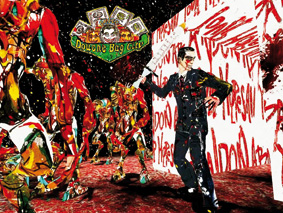
Federico Solmi
Douche Bag City
Animation | dv | color | 8:0 | Italy, USA | 2009
Douche Bag City is a video installation of 24 drawing animated film. It was conceived by the artist to be a satire about the current world economic crisis. The main character ?Dick Richman? is a greedy, dishonest, and selfish Wall Street employee who has been banished to live in Douche Bag City. Douche Bag City is a hopeless place, where the greedy villains of society are imprisoned for their atrocities committed against the community. The video is made of several chapters. In the final version of the installation, 24 videos/episodes will be playing simultaneously; each episode represents a mission for the main character. The ultimate goal of the protagonist ? Dick Richman? is to survive different challenges, but the drawing animated /video games are set by the artist in a way that the main character ?Dick Richman? cannot win. For each video I used a combination hand-made drawings, video game technologies, 3D and 2D animation. The installation was made in collaboration with Russell Lowe, an Australia-based 3D artist and professor at the New South Wales University in Sidney.
Federico Solmi was born in Bologna, Italy in April 1973 and currently lives and works in New York. His exhibitions, which often combine articulate installations composed of different media such as video, drawings, mechanical sculptures and paintings, use bright colors and a satirical aesthetic to portray a dystopian vision of our present day society. Irreverent, surrealistic, and sexually explicit, the videos and the works by Federico Solmi are as he is: extravagant, rowdy and ironic. They are satires about the evilness and the vices that affect contemporary society and mankind. In the year 2009, Federico Solmi was awarded by the Guggenheim Foundation of New York with the John Simon Guggenheim Memorial Fellowship in the category Video & Audio. Federico?s work has been featured in the following museums and Institutions for Contemporary art; Santa Fe Biennal (upcoming June 2010), Centre Pompidou, Paris, Drawing Center, New York; Haus der Kulturen der Welt, Berlin, National Center for Contemporary Art, Moscow, CA2M Centro de Arte Dos de Mayo, Madrid, Australian Center of Moving Images, Melbourne, Victoria Memorial Museum, Calcutta, India, Contemporary Art Center of Rouboix, Palazzo Delle Arti, Naples, Palazzo Delle Esposizioni, Rome, Italy.
Catalogue : 2009King Kong and the End of the World | 0 | dv | color | 4:27 | Italy, USA | 2006
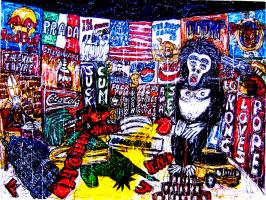
Federico Solmi
King Kong and the End of the World
0 | dv | color | 4:27 | Italy, USA | 2006
KING KONG AND THE END OF THE WORLD - 2005 - 2006 King Kong and the End of the World is a sensational and sarcastic drawing animated film, based on the original 1933 King Kong movie. In this version, King Kong (played by the alter ego of the artist) destroys New York City, using the Guggenheim Museum as a weapon, then he climbs to the top of the Empire State Building where he pees, eats wall street brokers for lunch, and fights the Statue of Liberty in the arena of Time Square. The artist uses King Kong as an allegory of the art world and the money-frenzy culture of the city. In this world, art is struggling against its role as a commodity. Ideas around the nature of money, technology, the natural and ?man-made? come together in the painstaking hand drawing of every frame. When he is finally killed, King Kong triggers a cataclysmic earthquake that destroys the earth or as it?s called by the artist ?the world of assholes?. All that is left is for Federico and his wife Jennifer to repopulate a better mankind using a baby making machine.
Federico Solmi was born in Bologna, Italy in April 1973 and currently lives and works in New York. His exhibitions, which often combine articulate installations composed of different media such as video, drawings, mechanical sculptures and paintings, uses bright colors and a satirical aesthetic to portray a dystopian vision of our present day society. Power is often the nemesis in his worlds, manifesting itself in the elliptical layers of the Guggenheim Museum (King Kong and the End of the World, video 2006), the shiny Prada shoes of the Pope (The Evil Empire, video 2007), and the personal obsession to be as famous as the giant letters that spell out ?Hollywood?. The artist uses images culled from the video game industry, pop culture, and the Internet and collages them with a historical influence to produce original artworks about the seemingly disparate subject at hand. What results from the combination of all these elements is art that is humorous, absurd, and scathingly critical of our contemporary society. .
Federico Solmi
Catalogue : 2023The Bacchanalian Ones | Experimental VR | 0 | color | 0:0 | USA | 2021
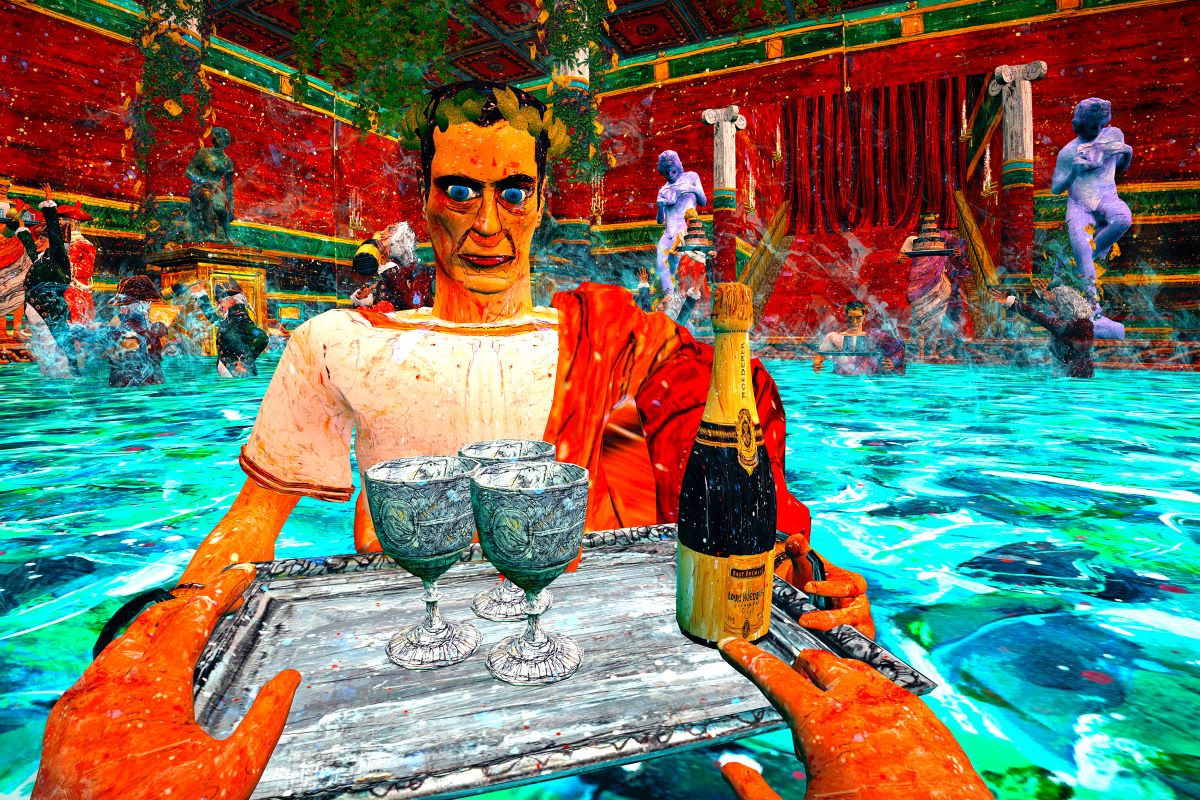
Federico Solmi
The Bacchanalian Ones
Experimental VR | 0 | color | 0:0 | USA | 2021
The Bacchanalian Ones, VR Experience for Oculus Quest 2 Inspired by ancient mythology, modern myth, and contemporary celebrity culture, The Bacchanalian Ones compares the historical myth with a satirical mash-up of the powerful self-absorbed who preen and wallow in a banal spectacle of their own creation. In a fantastically opulent setting of unrestrained hedonism, political, religious, and military leaders with ghoulish, bouffonesque appearances are surrounded by social elite sycophants like the devotees of the cults of Bacchus and Dionysus. Solmi’s phantasmagoric world of whirling space, jerking movement, and oscillating facades that strive to overwhelm the viewer’s visual field is pushed to extremes in a new interactive Virtual Reality installation. This work invites the visitor to enter the Bacchanal by donning a VR mask and manipulating two hand-held controllers in order to pick the perspective of one of his historical avatars. Newly empowered, and emboldened, the visitor is able to control the narrative, allowing them to experience the debauchery up close and personal through their embodiment of the avatar.
Federico Solmi was born in Bologna, Italy in 1973. Since 1999 he has lived and worked in New York. Solmi’s work utilizes bright colors and a satirical aesthetic to portray a dystopian vision of our present-day society. His exhibitions often feature articulate installations composed of a variety of media including virtual reality experiences, video installation, painting, drawing, and sculpture. Solmi uses his art as a vehicle to stimulate a robust conversation with his audience, highlighting the contradictions and fallibilities that characterize our time. In 2009, Solmi was awarded by the Guggenheim Foundation of New York with the John Simon Guggenheim Memorial Fellowship in the category of Video & Audio. Solmi’s work was included in the 100-year anniversary exhibition of The Phillips Collection, Seeing Differently, and in the Smithsonian National Portrait Gallery’s traveling exhibition, Outwin 2019: ‘American Portraiture Today,’ as well as the inaugural exhibition of the Ocean Flower Museum Island in Hainan Province, Danzhou, China. From 2016 to 2019 Federico Solmi was visiting Professor at Yale University School of Art, and Yale School of Drama, New Haven CT. Solmi was appointed guest critic at the Yale University School of Art for 2022.
Francisca Somigliana
Catalogue : 2021Diamante | Experimental fiction | 4k | color | 7:29 | Argentina | 2020
Francisca Somigliana
Diamante
Experimental fiction | 4k | color | 7:29 | Argentina | 2020
"Diamante" is built as a game of reflections on the basis of a fact: a jewelry theft committed in Russia in 2018 allegedly committed by a criminal organization called Pink Panther.
Francisca Somigliana (Buenos Aires, 1992) studied Image and Sound design. She did the Film Program (2017) and the Artist Program (2020/21) of the Universidad Torcuato Di Tella. She was selected in 2019 to participate in the Biennial of Young Art. She participated in different shows and screenings such as Space between (CCR), Today I have permission to lie (UTDT), Program 2016 (Dahaus Studio), Satellite XIII (CHELA) and Cinematographic images and their path to freedom (UTDT)
Helene Sommer
Catalogue : 2008Persistence of vision | Art vidéo | dv | color | 11:0 | Norway | 2007

Helene Sommer
Persistence of vision
Art vidéo | dv | color | 11:0 | Norway | 2007
?Persistence?* of vision is based upon an amateur film and video archive from a 90 year old man, from 1950 to present day. The focus is on his travels- from NY to South America during the 50s, Japan in the 60s, Egypt in the 70s to Spanish retirement villages during the 90s. By deconstructing and reassembling the material a new travelogue is created where time and place blends. ?Persistence of vision?* investigates how memory and perception function in regards to history and the act of documenting. The use of the camera as a way of seeing.
Helene Sommer was born in 1978 in Oslo, Norway. She studied Fine Arts at the National Academy of Fine Arts in Oslo. As an artist she works mainly within the fields of video, photo, text and installation. She has over the last year shown several places in Europe. She was recently a resident artist at Platform Garanti in Istanbul, and is currently a fellow at the Akademie Schloss Solitude in Stuttgart, within the discipline of Film/Video/New Media.
Catalogue : 2007Das Gelaende | Experimental video | dv | color | 7:56 | Norway, Germany | 2005
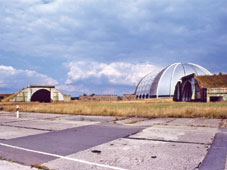
Helene Sommer
Das Gelaende
Experimental video | dv | color | 7:56 | Norway, Germany | 2005
The initial purpose of the trip was to observe the construction of an indoor tropical amusement park, but the intentions and interests change as the already existing landscape becomes inevitable. "Das Gelände" follows the construction of an indoor tropical amusement park in a former airship hangar, localized on what was previously a Soviet military base in the GDR. In the video, the history of the landscape is being uncovered at the same time as the construction of an artificial indoor landscape is being observed. As facilities change functions, the layers of history become apparent. The visible recycling of the landscape triggers the question of whether the amusement park trivializes, camouflages, or clarifies the place's history. The video consists of images from web cameras downloaded over a period of 9 months, in addition to photos and video collected during the construction period. A narrative is conveyed through subtitles, leaving only the sound of the landscapes.
Helene Sommer was born in 1978 in Oslo, Norway, where in 2003 she graduated from the National Academy of Fine Arts. She works with various media such as video, photo, text, and installations, and currently lives and works in Berlin and Oslo.
Wichanon Somumjarn
Catalogue : 2016The Young Man Who Came From the Chee River | Experimental fiction | hdv | color | 16:38 | Thailand | 2015
Wichanon Somumjarn
The Young Man Who Came From the Chee River
Experimental fiction | hdv | color | 16:38 | Thailand | 2015
Golf, a man who works as a debt claimer in Khonkaen. He wakes up early to work as usual. He meets many people including a desperate man in debt who falls critically ill. Golf is forced by the situation to weigh up between his professional duty and sense of moral.
Wichanon Somumjarn was born in Khon Kaen in 1982. While he was in the final year of studying engineering, he made a short film titled Phee Hong Nam (W.C.) The short won Honorable Mention at the Siam Cement Group Young Thai Artist Award 2005 in the film category. He then decided to leave his formal studies to pursue his dreams in the field of cinema. Wichanon was a participant in Asian Film Academy (AFA), Pusan International Film Festival 2009. In February 2010, Wichanon had also attended the Berlinale Talent Campus # 8 at the 60th Berlin International Film Festival, Germany. In November 2010, Wichanon had also attended the Next Master Tokyo Filmex 2010, Japan. His short film, Four Boys, White Whiskey and Grilled Mouse has been a major success on the international film festival circuit. It won Best Fiction award at the prestigious Tampere Film Festival in Finland in 2010. In April the Following Year, There was a Fire, is Wichanon’s first feature. In January 2012, it was selected for Tiger Awards Competition at International Film Festival Rotterdam 2012. Now Wichanon is developing his second feature called “Beer Girl”.
Kwang-ju Son
Catalogue : 2017Characters Revisited | Experimental doc. | 4k | color | 18:14 | Korea, South | 2016
Kwang-ju Son
Characters Revisited
Experimental doc. | 4k | color | 18:14 | Korea, South | 2016
The filmmaker begins to view CHARACTERS, her first feature film made in 2011, not from the outside as a product to be consumed, but from the inside, as an engaged performance of consciousness in and through which the story is both lost and regained in the actual process of filmmaking itself. Exploring the paradoxical boundary between two worlds, she focuses on the basic conditions of existence, identity and survival of an individual in a fictional world.
Since 2003 when she received the M.F.A. in Film/Video/New Media from the School of the Art Institute of Chicago, Kwang-Ju Son(b.1970) has presented her varied short projects of both film and video, at diverse venues & international film festivals.
Catalogue : 2008Amusement Epitome | Experimental doc. | dv | color | 2:46 | Korea, South | 2006

Kwang-ju Son
Amusement Epitome
Experimental doc. | dv | color | 2:46 | Korea, South | 2006
A weekday afternoon in the EverLand, one of the largest amusement parks in Korea.
Born 1970 in Korea, Kwang-Ju Son is a two-time award-winning filmmaker at the Pusan International Film Festival. She has presented her short films in major festivals including Pusan, Rotterdam, and Oberhausen. She is currently working as a resident artist at the Rijksakademie in Amsterdam, Holland.
Guston Sondin-kung
Catalogue : 2016STUXNET in Denmark | Video | 4k | color | 4:37 | USA, Denmark | 2015
Guston Sondin-kung
STUXNET in Denmark
Video | 4k | color | 4:37 | USA, Denmark | 2015
The Video work STUXNET in Denmark tells a hallucinatory realist fable about an unnamed intelligence officer who has participated in the cyber warfare attack against the Iranian Nuclear plant in Natanz from a hotel room in Copenhagen. What unfolds through the story is a dialogue about the fictive side of documents, participation and complicity in remote warfare, the trap of paranoia and the unattainable desire to be completely immune to mass surveillance. This video is based upon the real events of what has been termed the STUXNET virus, a cyber warfare weapon that was developed by a consortium of different government bodies as a way to disrupt the enrichment of uranium at the Iranian Nuclear plant in Natanz from 2010-2012. Cyber security experts have tracked the virus and discovered that one of the main control servers was located outside the city of Copenhagen, Denmark. It has been suggested by security analysts that because the control servers were located in Denmark then there would have been a forward operating command and control center set up in the country that was active during the time of the attack. An intelligence officer following standard operating procedure would have established this in a hotel and worked cloaked in what is referred to as a “security tent” that is specifically designed to create an electromagnetic shield around its exterior so as to disrupt any listening or watching devices.
Guston Sondin-Kung is a visual artist born in the USA and currently living in Copenhagen, Denmark. He works in a project-based manner primarily in the mediums of film/video, installation and writing. His artwork explores how historical narratives, memory, and ideology are constructed and influence our perception and thinking. Informed by marxist theory, psychoanalysis, postcolonial theory and feminism he is invested in deconstructing the complex intersections of race, class, and gender from a transnational perspective in order to pose alternative narratives and forms of representation. In addition to art institutions, he regularly presents his artworks and artistic research in academic, activist, educational and film festival contexts.
Ian Soroka
Catalogue : 2009Nostalgia | Experimental film | 16mm | color | 6:46 | USA, Czech Republic | 2008
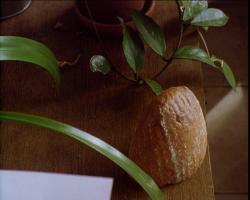
Ian Soroka
Nostalgia
Experimental film | 16mm | color | 6:46 | USA, Czech Republic | 2008
Nostalgia is a specific emotion that represents a patchwork of memories stitched together to create an idealized past. Through reflections of the banality of everyday life, Nostalgia explores the creation of filmic emotion and atmosphere. It seeks to construct a ?film? environment to allude not only to something inherently human but also to a collective emotional history.
Ian Soroka was born New York City and raised in the Mountain region of Colorado, USA. He has Accreditation from FAMU International: Film and TV School of the Academy of Performing Arts in Prague and is currently working towards a degree at the University of Colorado in Boulder.
Gustav Sparr
Catalogue : 2007Slide Projector: I.D. Roles Project | Animation | 0 | color | 27:46 | Sweden | 2006
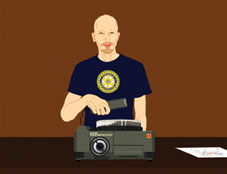
Gustav Sparr
Slide Projector: I.D. Roles Project
Animation | 0 | color | 27:46 | Sweden | 2006
A cast of clones are trapped inside a seminar room and subjected to a kind of presentation or slideshow. The slideshow features over a hundred images of board games, and seems to trigger, via a small mysterious ball of light, the audience of clones to sift through their notes and act out small, possibly internal or dreamlike, dramas. As the film progresses the identies start to get tangled and conflict arises, characters want to jump out of the system or structure, while some, seemingly in power, try to control the situation and preserve the order of things. The film unfolds and is driven trough the association and manipulation of symbols: One board game leads to the next and one identity refers to another in a sequential series of mind games that eats its own tail. The sub-stories of the film deal playfully and somewhat loosely with evolution, science, existentialism, and society, as well as mysticism and hierarchies. It is part of a larger artwork and film cycle begun in 2003 and scheduled for completion in 2007.
Gustav Sparr was born in 1977, grew up in the region of Stockholm, and currently lives and works in Umeå, Sweden. After having gradually shifted from sculpture, painting, and digital illustration, his work currently focuses on animation. References from popular culture, esotericism and scientific writings have been filtered through a rather direct visual language that hides many underlying and unorthodox connections of ideas. The most obvious framework or manifestation of these thought-experiments is through the both limiting and enriching world of board games and childlike acts, which are deciphered, re-interpreted and re-coded. The animations and images are concerned with questions about identity, self-image, structures, symbols, loops, surfaces, topology, vessels of information, lifeforms, and how thoughts and ideas are born and relate and mutate. Basically it's about the brain...
Isabell Spengler, Antonia Baehr, Jule Flierl - Filmed in a visual installation by Nadia Lauro
Catalogue : 2023Die Hörposaune | Experimental fiction | 0 | color | 29:38 | Germany | 2022

Isabell Spengler, Antonia Baehr, Jule Flierl - Filmed in a visual installation by Nadia Lauro
Die Hörposaune
Experimental fiction | 0 | color | 29:38 | Germany | 2022
Die Hörposaune (The Hearing Trombone) film / installation by Isabell Spengler, Antonia Baehr, Jule Flierl, Germany 2022 filmed in a visual installation by Nadia Lauro short synopsis Through a floating camera motion, the film invites us to enter a world with its own logic, passing through sensitive membranes, liquefied borders and openings between inner and outer spaces. Here we attend a reading circle or vocal performance in memory of the counter tenor and queer icon Klaus Nomi, one of the first public figures to die within the AIDS pandemic. Daydream-like, as if to save them from oblivion, the film delves into the guts of fantastical, queer body imaginations - with spit, panting, oral sounds, singing, and vulva-like paper flower arrangements, whereby anatomical representations are reinterpreted.
Isabell Spengler (director) is a film/video artist from Berlin. In her films, installations and performances she analyzes and mediates diverging constructions of realities, imaginary worlds and their representation. Since 2005 she has created a series of conceptual Expanded Cinema works in dialogues with other artists. /www.isabellspengler.net Antonia Baehr (director) is a choreographer living in Berlin. Her pieces explore, among other things, the fiction of the everyday and the theater. She has worked with scores for many years - as a way to connect and collaborate. Baehr is producer of horse whisperer and dancer Werner Hirsch (performer in Die Hörposaune). /www.make-up-productions.net Jule Flierl (director) is a dance and voice artist from Berlin. She develops practices that conceive of the voice as a dancer. She revives the legacy of Valeska Gert, avant-garde dancer from 1920's Berlin, who first conceptualized the term ToneDance: to dance with one's voice. Her practice unsettles the relationship between seeing and hearing. /juleflierl.weebly.com Nadia Lauro (visual installation) is a visual artist and designer based in Paris, who works across contexts including scenic spaces, landscape architectures, museums. She conceived set designs, environments and visual installations with strong dramaturgical power, thus generating new ways of seeing and being together. /https://nadialauro.com
Isabell Spengler, Larry Peacock
Catalogue : 2008Syncpoint | Experimental film | 16mm | color and b&w | 3:54 | Germany | 2007
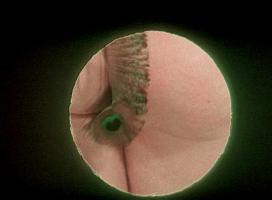
Isabell Spengler, Larry Peacock
Syncpoint
Experimental film | 16mm | color and b&w | 3:54 | Germany | 2007
Translating a musical stage performance by the group "Larry Peacock" into the language of film, SYNCPOINT combines film images created directly on film leader with those created through normal exposure of 24 frames per second with a 16mm film camera. Central to this experimental music video is the image of the synchronization-point as a hole, derived from the film-technical synchronization method of punching a hole into the first exposed and keycode-numbered frame of a roll of film prior to its transfer to video. The image of the hole does not only mark a point in time, but is in connection with the photographically captured (percussion-) actions of the performers perceived either as a round mask of censorship or as a filled, dot-shaped image. Purposefully designed and random synchronicities between the visual and accustic events allow for a variety of interpretive connections. Larry Peacock is a feminist project with and about the performativity of electronic/pop music, reflecting gender politics and the role of the audience. The project not only destabilizes the normativity of binary gender categories, but also art categories such as ?high` and `low`, ?dance?, ?concert-performance?, and ?choreographic work?.
Isabell Spengler, born in Berlin, studied experimental film at the Universität der Künste in Berlin and at the California Institute of the Arts in Valencia. She was a recipent of a DAAD grant and a Eastman Kodak stipend. She currently teaches film at the Universität der Künste in Berlin. Her filmography includes "Psychic Tequila Tarot" (1998), ?Transformation in the Land of Enchantment? (2003), ?The Natural Life of Mermaids? (2004) and ?Permanent Residents? (2005). Her work including films, video installations and photography has recently been exhibited at Los Angeles Film Forum; Cirrus gallery, Los Angeles; Cerealart, Philadelphia; Taxter & Spengemann, New York; KunstWerke - Berlin e.V. - Institute for Comtemporary Art; Internationale Filmfestspiele Berlin (Berlinale 2007) and at the Museum Ludwig, Cologne, Germany. distribution & further information: http://www.fdk-berlin.de/en/arsenal-experimental/kuenstler/isabell-spengler.html
Catalogue : 2007Permanent Residents | Experimental film | 16mm | color | 9:32 | Germany, USA | 2005
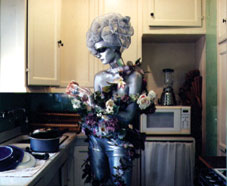
Isabell Spengler
Permanent Residents
Experimental film | 16mm | color | 9:32 | Germany, USA | 2005
The film "Permanent Residents" combines extreme costume design with staged documentation of everyday activities in the urban space of Los Angeles. The costumes point to a collective imaginary world, which consists of the floating signifiers of pop-icons, myths, and social fictions. The protagonists of the film communicate in a non-verbal language across spatial distances. Their simultaneous movements at different locations merge into a choreography, which draws our attention to musical and abstract visual aspects in the design of our environment. A portrait of the city's influence on its residents.
Isabell Spengler, born in Berlin (Germany), studied experimental film at the Universität der Künste in Berlin (Meisterschülerin 1999) and at the California Institute of the Arts in Valencia (MFA 2001). She was a recipent of a DAAD grant and a Eastman Kodak stipend. She currently teaches film at the Universität der Künste in Berlin. Her filmography includes "Psychic Tequila Tarot" (1998), "Transformation in the Land of Enchantment" (2003), and "The Natural Life of Mermaids" (2004). Her films have received awards at the NoBudget Festival in Hamburg, the Gera International Short Film Festival, and the Göttinger Low Budget Film Festival. Her work has recently been exhibited at Los Angeles Film Forum, Cirrus Gallery, Los Angeles; the Australian Center for Photografy, Sydney; the Museum Ludwig, Cologne; and at KunstWerke Institute for Contemporary Art, Berlin.
Isabell Spengler
Catalogue : 2008Syncpoint | Experimental film | 16mm | color and b&w | 3:54 | Germany | 2007

Isabell Spengler, Larry Peacock
Syncpoint
Experimental film | 16mm | color and b&w | 3:54 | Germany | 2007
Translating a musical stage performance by the group "Larry Peacock" into the language of film, SYNCPOINT combines film images created directly on film leader with those created through normal exposure of 24 frames per second with a 16mm film camera. Central to this experimental music video is the image of the synchronization-point as a hole, derived from the film-technical synchronization method of punching a hole into the first exposed and keycode-numbered frame of a roll of film prior to its transfer to video. The image of the hole does not only mark a point in time, but is in connection with the photographically captured (percussion-) actions of the performers perceived either as a round mask of censorship or as a filled, dot-shaped image. Purposefully designed and random synchronicities between the visual and accustic events allow for a variety of interpretive connections. Larry Peacock is a feminist project with and about the performativity of electronic/pop music, reflecting gender politics and the role of the audience. The project not only destabilizes the normativity of binary gender categories, but also art categories such as ?high` and `low`, ?dance?, ?concert-performance?, and ?choreographic work?.
Isabell Spengler, born in Berlin, studied experimental film at the Universität der Künste in Berlin and at the California Institute of the Arts in Valencia. She was a recipent of a DAAD grant and a Eastman Kodak stipend. She currently teaches film at the Universität der Künste in Berlin. Her filmography includes "Psychic Tequila Tarot" (1998), ?Transformation in the Land of Enchantment? (2003), ?The Natural Life of Mermaids? (2004) and ?Permanent Residents? (2005). Her work including films, video installations and photography has recently been exhibited at Los Angeles Film Forum; Cirrus gallery, Los Angeles; Cerealart, Philadelphia; Taxter & Spengemann, New York; KunstWerke - Berlin e.V. - Institute for Comtemporary Art; Internationale Filmfestspiele Berlin (Berlinale 2007) and at the Museum Ludwig, Cologne, Germany. distribution & further information: http://www.fdk-berlin.de/en/arsenal-experimental/kuenstler/isabell-spengler.html
Catalogue : 2007Permanent Residents | Experimental film | 16mm | color | 9:32 | Germany, USA | 2005

Isabell Spengler
Permanent Residents
Experimental film | 16mm | color | 9:32 | Germany, USA | 2005
The film "Permanent Residents" combines extreme costume design with staged documentation of everyday activities in the urban space of Los Angeles. The costumes point to a collective imaginary world, which consists of the floating signifiers of pop-icons, myths, and social fictions. The protagonists of the film communicate in a non-verbal language across spatial distances. Their simultaneous movements at different locations merge into a choreography, which draws our attention to musical and abstract visual aspects in the design of our environment. A portrait of the city's influence on its residents.
Isabell Spengler, born in Berlin (Germany), studied experimental film at the Universität der Künste in Berlin (Meisterschülerin 1999) and at the California Institute of the Arts in Valencia (MFA 2001). She was a recipent of a DAAD grant and a Eastman Kodak stipend. She currently teaches film at the Universität der Künste in Berlin. Her filmography includes "Psychic Tequila Tarot" (1998), "Transformation in the Land of Enchantment" (2003), and "The Natural Life of Mermaids" (2004). Her films have received awards at the NoBudget Festival in Hamburg, the Gera International Short Film Festival, and the Göttinger Low Budget Film Festival. Her work has recently been exhibited at Los Angeles Film Forum, Cirrus Gallery, Los Angeles; the Australian Center for Photografy, Sydney; the Museum Ludwig, Cologne; and at KunstWerke Institute for Contemporary Art, Berlin.
Gustavo Spolidoro
Catalogue : 2010De Volta ao Quarto 666 | Documentary | dv | color | 15:10 | Brazil | 2009
Gustavo Spolidoro
De Volta ao Quarto 666
Documentary | dv | color | 15:10 | Brazil | 2009
What is the future of cinema? In 1982, in Cannes, Wim Wenders invited many moviemakers to answer this question. 26 years later, the question remains, but Wenders is now on the other side of the camera.
Inspired by his father, a cinemaniac, Gustavo Spolidoro started to explore the world of film early on and inspired by filmmakers like Rogério Sganzerla and Woody Allen started his career as a director.
Alcaeus Spyrou
Catalogue : 2019Anina | Video | hdv | color | 19:51 | Greece, United Kingdom | 2017
Alcaeus Spyrou
Anina
Video | hdv | color | 19:51 | Greece, United Kingdom | 2017
A container ship is not an inanimate object. The ship that travels thousands of miles on the high seas is full of life, stories, tragedy and hope. The harbours reached, the industrial landscape one encounters, the cargo that floats in an endless ocean. Anina is a psycho-geographic film-essay, documenting the ethnographic tendencies of the industrial landscape and its malevolent stature over the individual. The shipping industry’s ever-shifting landscape, affecting even this interaction you are having with this text, crafts its own mythology.
Alcaeus Spyrou (b.1991, Elbasan, Albania) is a visual artist working with the cinematic image. He was born on the day the fall of the Hoxha dictatorship in Albania. The conflict that ensued, forced his family to seek refuge in Athens, Greece. The frequent displacement and oscillation between the two topographies, would focus Alcaeus’s gaze towards the shifting landscape of migration. In his practice, Alcaeus utilizes a psychoanalytical scope on cinema to deconstruct the inter-dependent nature of the medium. Through this process, he searches for new dialects of the cinematic language. By combining the two antithetical genres of fiction and non-fiction he establishes connections with the alienated environment. He informs the mythologies of contemporary migration that reveal collective trauma as the substance of our intricate relations to the other.
Giulio Squillacciotti
Catalogue : 2025A War Play | Experimental fiction | 16mm | color | 8:0 | Italy | 2024
Giulio Squillacciotti
A War Play
Experimental fiction | 16mm | color | 8:0 | Italy | 2024
Around 1920, a wealthy man from northern Italy returns from the First World War. Without having actively fought, neither having seen the blood of battle or an actual trench, he asks a group of people to stage for his camera scenes from the war as he imagined it. In 2024, four individuals are asked, in an attempt at freezing time, to didactically re-enact the scenes already staged in the 1920s photographs. In the corridors of a war museum housing a series of dioramas depicting war landscapes without figures, the endless cycle of the representation of war unfolds in an infinite suspended moment.
Giulio Squillacciotti is an artist and film-director born in Rome in 1982, living and working in Milan. After an education in Medieval Art History and Humanities in Rome and Barcelona, he studied Visual Arts at the University of Architecture in Venice. He was a fellow resident at the Jan Van Eyck Academie in Maastricht and one of the artists of the Dutch pavilion at the 2018 Architecture Biennale. His work is oriented mainly on the invention and mutation of traditions by merging together fiction and historical facts. Using film, documentary, sound and scenography, Squillacciotti produces research-based investigations that revisits history, crafting new stories from subjective perspectives, religion, language and popular culture. He is currently working on his first fiction feature film, co-produced among Italy, Ireland and Poland, project recipient, so far, of the MEDIA Creative Europe Grant and the Screen Ireland writing fund.
Catalogue : 2021What Has Left Since We Left | Experimental fiction | 4k | color | 21:15 | Italy, Netherlands | 2020
Giulio Squillacciotti
What Has Left Since We Left
Experimental fiction | 4k | color | 21:15 | Italy, Netherlands | 2020
On February 7th 1992, the Treaty on European Union was signed in the Dutch city of Maastricht. Decades later, the representatives of the last three countries left in Europe meet again in the very same room where it was signed, this time to deliberate on the permanent shutdown of their Union. In what seems to be a looped therapy session, the three characters - helped by a British interpreter as a self-appointed analyst - try to deal with their feeling of loss. The conversation allows their political and personal bonds to be woven together metaphorically, compelling them to face their identity crisis and acknowledge what is left, what no longer is and what still could be of their Union.
Giulio Squillacciotti (Born in Rome, Italy 1982) Artist and film-maker lives and works between Milan (I) and Maastricht (NL). He studied Medieval Art History in Barcelona and Rome, where he earned a BA in Humanities from Sapienza University and holds a MA in Visual Arts from the Venice University of Architecture IUAV. His work is mainly oriented on storytelling, cultural apexes and the way traditions re-shape in new contexts. His research merges together fiction and historical facts. Using film, documentary, sound and set design, Squillacciotti produces research-based investigations that revisits history, crafting new stories from subjective perspectives, religion and popular culture. His work has been exhibited and screened internationally at, among the others, the Dutch Pavilion of the Venice Architecture Biennale, Les Rencontres Internationales at Centre Pompidou, Palais de Tokyo, La Fe?mis and Gayte Lyrique in Paris and Centre d’Art Contemporain de Brest (F), at the Berlin Haus der Kulturen der Welt and Neues Museum in Weimar (D), Screen Space in Melbourne (AU), the Manifesta 8 in Murcia (E), Le Magasin CNAC in Grenoble (F), AKV of Den Bosch (NL), Istanbul 2010 European Capital of Culture (TR), the Beirut Art Centre in Lebanon (RL), the New York Photo Festival, Dumbo Video and the Columbia University in New York City (USA), Art Institute of Boston (USA), the Los Angeles Now Instant Image Hall (USA), OCAT in Shanghai (PRC); in Italy at PAC, Triennale, MACRO, MAXXI, 16th Quadriennale of Rome, MAMbo, Sandretto Re Rebaudengo and at the Official Competition of the 33rd, 35th and 36th Torino Film Festival.
Catalogue : 2012Casi la mitad de la historia | Fiction | | color | 7:46 | Italy | 2011
Giulio Squillacciotti
Casi la mitad de la historia
Fiction | | color | 7:46 | Italy | 2011
All the memory of the world is contained in an old Academy we don?t know the location and time. The quarrel between two men from two different generations is told through vocal notes as annotations for a possible story yet to be told. The argument stands in the chances History has to be written. How do these two persons can tell a story? How do they deal with what History already told and what is possible to add? How to tell something while is happening? A story telling method as an inheritance, to be passed on from Maestro to pupil in the aseptic spaces of an Academy. Looking for the right balance between tradition and the possible re-invention of it, as two different generations and their different approach to key words of the Historic Study. The voice leading us to these spaces has never a face, but her subjective eye has the right detach of the present on past issues. Shot for the double solo show of Antoni Muntadas and Giulio Squillacciotti in Rome (I) in 2011.
Giulio Squillacciotti (Rome, Italy 1982) studied Medieval Art History in Barcelona and Rome, where he got his BA from Sapienza University. He earned a Master?s Degree (hons) in Visual Arts from the School of Architecture in Venice in 2009, where he studied Philosophy, Semiotics and Anthropology. Once completed his studies he won, again in Venice, a one year residency at the Bevilacqua La Masa Foundation with the Ateliers Program. Never trained as an artist, neither a film maker, his work is mainly oriented on storytelling and cultural apexes and their possible reinvention in different contexts. He deals with the idea of tradition and the fictitious outlets of it, all spread through a system of layered meanings, which formally goes from film to documentary, from installation to live performing and talks. His works and talks have been shown and heard in New York and Boston (USA), Den Bosch (NL), Paris and Grenoble (FR), Istanbul (TR), Murcia (Manifesta 8, ES), Prague (CZ), Teheran (IR), Weimar (D); in Italy in Rome, Milan, Turin, Venice and Verona. He recently finished the editing of a feature documentary film (RMHC) on the punk/hardcore scene in Rome from the 80s and 90s.
Catalogue : 2012Zimmerreise | Fiction | super8 | color | 2:30 | Italy, Austria | 2010
Giulio Squillacciotti
Zimmerreise
Fiction | super8 | color | 2:30 | Italy, Austria | 2010
A woman wanders around the 19th floor of a building, from an anonymous industrialized city. She has been told, through a series of cryptic indications, how to paint an imaginary landscape where to meet with the author of those letters. The geographical and physical distance with the person who is writing to her, can be reduced only through a methodic work of imagination and detach from what is surrounding her. The chance of traveling from a room, by seeing with eyes closed, to a place that exists only in both their minds. The difficult task is here expressed by the contradictory indications he gives her, as an explicit giving of what is a long distance communication with its time lapses. The strength to disclose the hitch can only be found in the accurate recollection of memories she has of their real encounters, once happened, far in time, but far, from where they both came.
Giulio Squillacciotti (Rome, Italy 1982) studied Medieval Art History in Barcelona and Rome, where he got his BA from Sapienza University. He earned a Master?s Degree (hons) in Visual Arts from the School of Architecture in Venice in 2009, where he studied Philosophy, Semiotics and Anthropology. Once completed his studies he won, again in Venice, a one year residency at the Bevilacqua La Masa Foundation with the Ateliers Program. Never trained as an artist, neither a film maker, his work is mainly oriented on storytelling and cultural apexes and their possible reinvention in different contexts. He deals with the idea of tradition and the fictitious outlets of it, all spread through a system of layered meanings, which formally goes from film to documentary, from installation to live performing and talks. His works and talks have been shown and heard in New York and Boston (USA), Den Bosch (NL), Paris and Grenoble (FR), Istanbul (TR), Murcia (Manifesta 8, ES), Prague (CZ), Teheran (IR), Weimar (D); in Italy in Rome, Milan, Turin, Venice and Verona. He recently finished the editing of a feature documentary film (RMHC) on the punk/hardcore scene in Rome from the 80s and 90s.
Marina Stanimirovic
Catalogue : 2023Des carcasses de tout | Experimental doc. | mov | color | 4:15 | France, Germany | 2022

Marina Stanimirovic
Des carcasses de tout
Experimental doc. | mov | color | 4:15 | France, Germany | 2022
Recorded in France and Germany, "CARCASSES OF ALL KINDS" is a wild recording of a discussion with my mother before it was too late. My mother, who was ill, told me about our first return to Bosnia and Herzegovina, the year following the end of the war. But this piece is not so much about war as about fragility, our memories, scars and departure. The voice and the words are used as sculptural material and mixed with additional recorded sounds. It uses recordings made in the cancerology department of the Argenteuil hospital center, rubbing of clothes, cutting of glass and metal, hammering, an industrial printer and vocals. Every summer, my mother used to cut lavender from her garden and place it in used stockings. After she died, I collected it all in the same bag. The video is a dive into that bag.
Marina Stanimirovic (1988, Argenteuil) is a French born artist based in Berlin. She studied Contemporary Jewellery at the Ecole Boulle, in Paris (2007 - 2011), and London, were she completed a Master at the Royal College of Arts (2011 - 2013). From violence against women to social disparities or dysfunctional economic systems she observes the ugly, the beautiful, the sad, the absurd and translate it through sculptures, installations, photography, video and sound experimentations. In 2022 she initiate DERIVAT, a platform that invites to reflect on the contemporary art market. Since 2023, she is part of the curatorial board of the project space Gr_und, Wedding Berlin.
Annette Stav Johanssen
Catalogue : 2008HANG SAFELY DIE SLOWLY | Experimental video | dv | color | 6:0 | Norway, Sweden | 2007

Annette Stav Johanssen
HANG SAFELY DIE SLOWLY
Experimental video | dv | color | 6:0 | Norway, Sweden | 2007
A media-exorsistic agentcy act, where unpredictability functions as the developing map. It challenges the post-speculative behaviourisme, where role and character is pre-determined in pre-written script. It seeks risk, chances, immense movement and embodied situations, direct reaction and continually action. The choice of dramaturgi is an extraction from Aristotelian and Hollywood thinking, where the essence of action and composition always is driven by hinder and conflict, planted in the pre-written story line with the involved character. The set-up is a Brechtian technic, where the film-medium is illustrating it´s illusion, and in that moment becomes an alienated effect of narration. There is one rule; control the whole system, be the inside picture and manage the outside frame. There is one room, the door is locked, you should be safe. WE, strapped in the system of informative totality, this has become an act of formality.
Annette Stav Johanssen, 1979 from Kristiansand in Norway, but for the moment lives and work in Malmö, Sweden. She is an artist, mainly producing performances, video, text-wriring and concerts.She often uses herself as performer, challenging the embodiedment situation, and also experiment a lot with the voice (even though this is a silent movie, Hang Safely Die Slowly). She is a member of Fine Art Union, in collaboration with Synnøve G. Wetten, another norwegian artist. Fine Art Union; is an interdiciplinary, mixed media, collaboration who operates in the dynamic of spectacular expressions bounced against controlled analytic behavior, through neo sci-fi-cinematic and ritualistic actions.
Christopher Steel
Catalogue : 2006Tube | Experimental film | 16mm | black and white | 7:30 | United Kingdom | 2004
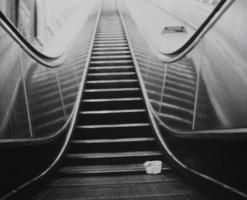
Christopher Steel
Tube
Experimental film | 16mm | black and white | 7:30 | United Kingdom | 2004
The daily spectacle of London?s underground train network is emphasized by in-camera superimposition and perfected by the removal of advertising and graffiti by painting on the negative.
Born Roehampton 1968; Edinburgh University 1990; 16mm Film Production course at the Half-Way Production House, Balham, 1993; Joined London Film-Makers? Coop 1993.
Lisa Steele, Kim Tomczak
Lisa Steele, Kim Tomczak
Catalogue : 2019The Afternoon Knows What the Morning Never Suspected | Experimental doc. | 4k | color and b&w | 21:0 | Canada | 2018
Lisa Steele, Kim Tomczak
The Afternoon Knows What the Morning Never Suspected
Experimental doc. | 4k | color and b&w | 21:0 | Canada | 2018
The Afternoon Knows What the Morning Never Suspected. It is a 3-channel 22-minute work that opens with a brief history of the Vietnam War, assembled from historical documents and footage, and then proceeds to detail Canada's complicity in the conflict, drawing attention to the massive profit that Canadian companies made during this time. The work also references the American draft dodgers who settled in Canada in the late 1960s, creating a context for the connection to today with a mesmerizing drive down Yonge Street in 2017. It is an interesting time to re-examine Canada's self-view in relation to the Vietnam War: yes we took in the draft dodgers (the work makes ample reference to this) but we also profited from the war (in spite of the fact that these profits were strictly against our own laws). The work concludes with the on-screen presence of our two performers, each telling the other's life story: one a first generation Canadian, the child of a Serbian/Croatian marriage; the other born in Canada to Vietnamese immigrant parents.
Lisa Steele and Kim Tomczak have worked exclusively in collaboration since 1983, producing videotapes, performances and photo/text works. In 2009, Steele + Tomczak were awarded an Honourary Doctorate by the University of British Columbia (Okanagan); in 2005, a Governor General`s Award for Lifetime Achievement in Visual & Media Arts; in 1994 they received both a Toronto Arts Award and the Bell Canada prize for excellence in Video Art. They are co-founders of Vtape, an award-winning media arts centre established in 1983 in Toronto. Currently Steele is Artistic Director and Tomczak is Restoration and Collections Management Director. Both teach at the University of Toronto in The John H. Daniels Faculty of Architecture, Landscape, and Design. Major public art commissions include: Watertable (2009, and expanded in 2011) a light and sound installation under the Gardiner Expressway (a raised highway) that marks the original shoreline of Lake Ontario at the foot of historic Fort York; …bump in the night (Barrie) (2010) commissioned by McLaren Art Centre and installed in bus shelters; Falling Up (2006) a video work for the Winnipeg Art Gallery; Love Squared (2006) screened on the 2400 square foot video board at Yonge & Dundas Square in Toronto. A major survey of their work, The Long Time: the 21st century work of Steele + Tomczak, curated by Paul Wong (with a 84 page catalogue), opened at On Main Gallery and VIVO, Vancouver, BC in September 2012; the exhibition traveled to A Space Gallery, Toronto, ON (2013), the Art Gallery of Windsor, ON (2016-17), and Dalhousie University Art Gallery, Halifax, NS (2017). Legal Memory, their first feature-length work, has been shown in a number of film festivals since its release including: The Los Angeles Gay and Lesbian Festival, the Festival Internazionale Cinema Giovani (Turin, Italy), the Toronto Festival of Festivals and broadcast on TVOntario. In 1996, their work BLOOD RECORDS: written and annotated, received a world premiere at the Museum of Modern Art in New York and toured across Canada with a bi-lingual catalogue published by The Oakville Galleries. Recent solo exhibitions of their works have taken place at Anna Leonowens Gallery, Halifax, (2014); Le Mois de la Photo a Montreal (2011); WHARF Centre D`art contemporain, Herouxville-St. Clair, France (2010); Diaz Contemporary, Toronto (2009); Akademie Schloss Solitude, Stuttgart, (2009); Dazibao, Montreal (2008); the Canadian Cultural Centre, Paris (2003). Selected group exhibitions and screenings of their work include: Every. Now. Then. Reframing Nationhood, Art Gallery of Ontario (2017); Imago Mundi, Instituto Veneto di Scienze, Lettere e Arti, Venice, Italy (2017); La Biennale de Montréal, Musee d'art contemporain de Montréal (2014); Carbon 14: Climate is Culture, Royal Ontario Museum, Toronto (2013); STITCHES: Suzhou Fast Forward, Workshop, Toronto (2011); Empire of Dreams: phenomenology of the built environment at the Museum of Contemporary Canadian Art, Toronto (2010); a focus screening at EXIS: Experimental Film and Video Festival in Seoul, Korea (2010); the Berlin Film Festival, Forum Expanded (2009); Akbank Sanat, Istanbul (2009); TIFF (Toronto International Film Festival) Future Projections (2009); Sophia, Bulgaria at the Central Bath House (2008); a focus screening at Rencontres Internationales Paris/Berlin/Madrid (2006); Beyond/In Western New York, organized by Albright Knox Gallery, Buffalo (2005); Trivandrum Video Festival, New Delhi (2003); City of York Public Gallery, York, England (2000).
Lisa + Kim Steele, Kim TOMZAK